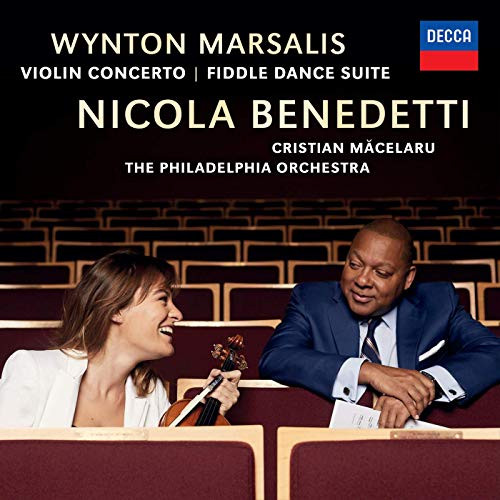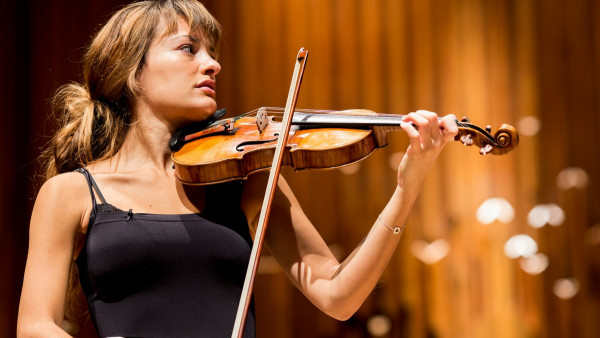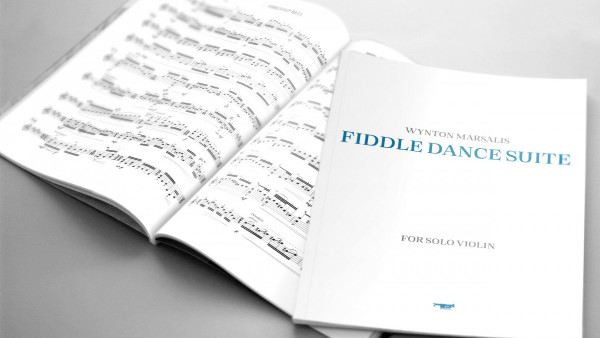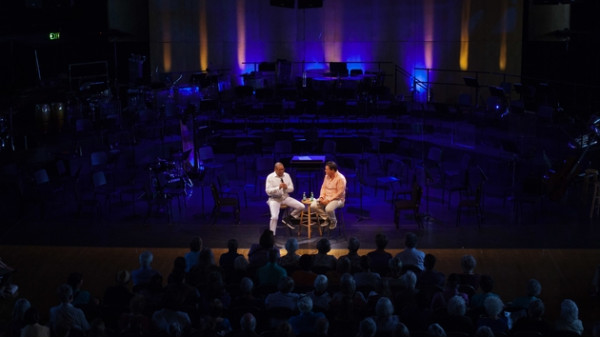Wynton Marsalis: Violin Concerto; Fiddle Dance Suite
Nicola Benedetti’s new album on Decca Classics features premiere recordings of two works written especially for her by jazz musician Wynton Marsalis: Violin Concerto in D and Fiddle Dance Suite for Solo Violin.

Album Info
| Ensemble | Nicola Benedetti with The Philadelphia Orchestra |
|---|---|
| Release Date | July 12th, 2019 |
| Recording Date | November 2–4, 2017; March 27, 2019 |
| Record Label | DECCA |
| Catalogue Number | 4850013 |
| Formats | CD, Digital Download |
| Genre | Classical Recordings |
| Digital Booklet | Download (pdf, 3 MB) |
Track Listing
| Track | Length | Preview |
|---|---|---|
| VIOLIN CONCERTO in D | ||
| Rhapsody | 12:38 | Play |
| Rondo Burlesque | 10:10 | Play |
| Blues | 10:18 | Play |
| Hootenanny | 10:19 | Play |
| FIDDLE DANCE SUITE FOR SOLO VIOLIN | ||
| Sidestep Reel | 3:59 | Play |
| As the Wind Goes | 4:07 | Play |
| Jones’ Jig | 4:05 | Play |
| Nicola’s Strathspey | 4:27 | Play |
| Bye-Bye Breakdown | 7:00 | Play |
Liner Notes
WYNTON MARSALIS: WORKS FOR VIOLIN
Concerts call the community to a common table. Before playing a single note, the symphony orchestra sits in magnificent halls in the center of cities around the globe, a visual embodiment of cross-cultural cooperation and citizenship. Superbly attired and finely tuned, of diverse ages, genders, nationalities and perspectives, they interpret a living library of unprecedented breadth, depth and sophistication to inspire communities to reflect on the deepest human issues that have confronted us for millennia. When you consider the collective knowledge and skill of conductor, ensemble, composer and virtuoso, a single concert marshals immeasurable creativity in the service of civilization.
Concerto in D
This piece was written for Nicola Benedetti. It takes inspiration from her life as a traveling performer and educator who enlightens and delights communities all over the world with the magic of virtuosity. Scored for symphony orchestra, with tremendous respect for the demands of that instrument, it is nonetheless written from the perspective of a jazz musician and New Orleans bluesman. We believe that all human beings are connected in the essential fundamentals of life: birth, death, love, and laughter; that our most profound individual experiences are also universal (especially pain); and acknowledging the depth of that pain in the context of a groove is a powerful first step towards healing.
Nicky asked me to “invite a diverse world of people into the experience of this piece”. Because finding and nurturing common musical ground between differing arts and musical styles has been a lifetime fascination of mine, I was already trying to welcome them. It may seem simple enough, but bringing different perspectives together is never easy. The shared vocabulary between the jazz orchestra and the modern orchestra sits largely in the areas of texture and instrumental technique. Form, improvisation, harmony, and methods of thematic development are very different. The biggest challenges are: how to orchestrate the nuance and virtuosity in jazz and blues for an ensemble not versed in those styles (a technical issue); and how to create a consistent groove without a rhythm section (a musical/philosophical issue).
Because modern living is an integrated experience, it is never difficult to discover organic connections. Turning those insights into something meaningful and playable, however, is another story. It has to be lived and digested. That’s why I looked for real-life examples in the history of jazz–symphonic collaborations and to the environment and experience that connect Nicky and me. I considered aspects of her Scottish ancestry, the great Afro- American abolitionist Frederick Douglass’s love of legendary Scottish poet Robert Burns, my love and inextinguishable respect for Scottish baritone saxophonist Joe Temperley (and his gleeful recitation of pungent limericks), and the luminous but obscure achievements of Afro-American keyed bugler Francis Johnson, father of the American cornet tradition and one of the first published American composers… who was also a fine fiddler. These sources led me to reconnect with the Anglo-Celtic roots of Afro-American music.
The piece opens with Nicky whispering a solo note before the orchestra enters, as if to say “And so it came to pass” or “Once upon a time”. Then we are into a form constructed in fours – as in the four corners of the earth, where her travels take her.
Each of the four movements, Rhapsody, Rondo Burlesque, Blues and Hootenanny, reveals a different aspect of her dream, which becomes reality through the public storytelling that is virtuosic performance.
Movement 1, Rhapsody, is a complex dream that becomes a nightmare, progresses into peacefulness and dissolves into ancestral memory.
Movement 2, Rondo Burlesque, is a syncopated, New Orleans jazz, calliope, circus clown, African gumbo, Mardi Gras party in odd meters.
Movement 3, Blues, is the progression of flirtation, courtship, intimacy, sermonizing, final loss and abject loneliness that is out there to claim us all.
Movement 4, Hootenanny, is a raucous, stomping and whimsical barnyard throw-down. She excites us with all types of virtuosic chicanery and gets us intoxicated with revelry and then… goes on down the Good King’s highway to other places yet to be seen or even foretold.
As in the blues and jazz tradition, our journey ends with the jubilance and uplift of an optimistic conclusion. All of us – Nicky, our conductor Cristi Ma ̆celaru, The Philadelphia Orchestra, our Producer Steve Epstein and I – have come together to make a mutual statement on the common sophistication and soul in our respective and collective art that we hope can be enjoyed by any and all.
Fiddle Dance Suite for Solo Violin
“Dancing never made nobody cry.” John Birks “Dizzy” Gillespie
Movement 1, Sidestep Reel. In the 19th and into the 20th century, repetitive, even- metered reels and hornpipes were the centerpiece of many a dance. Easy and fun, their infectious, sing-songy melodies stayed in the mind and on the tongue. Even though the most adventurous fiddlers were given to outlandish syncopations on these forms, this is not a reel you would dance. It is super-syncopated, and the odd meters would leave you looking for a seat. These melodies are a homegrown concoction of commonality between traditional fiddle tunes, the Baroque, ragtime, bebop, the quartal melodies of modern jazz and the fancy variations on themes as popularized in the 19th century.
Movement 2, As the Wind Goes, is the wistful late-night song of a lullaby, a campfire song, a ballad… a spiritual. It is sung as if on the wind, yearning to experience once again that which will only ever again live as memory.
Movement 3, Jones’ Jig. The Irish jig, the African 6/8 bell pattern, the shuffle rhythm of jazz and the drum style of Elvin Jones all play around with the relationship of three in the time- space of two. The juxtaposition, negotiation and reconciliation of these opposing rhythmic perspectives create interesting musical relationships all over the planet.
Movement 4, Nicola’s Strathspey. In the traditional strathspey, improvised embellishments, syncopated dotted rhythms and the use of space between notes create expectation, momentum and surprise. These same elements and their effect on the listener are mirrored in the blues. In this ever-quickening strathspey-blues, it seemed like a natural marriage.
Movement 5, Bye-Bye Breakdown. This is good ol’ Saturday-night-barn-dance, hoedown fiddling. It revels in the whining cry of open double stops, in all types of musical onomatopoeia from train sounds to animal calls to country whistling, and in the steady 2/4 rhythm that is as basic as walking. The harmonic framework of several popular fiddle and folk tunes provides a practical grid for Nicky to cut challenging melodic and rhythmic figures. After a reflective interlude, we get right back to it. This is designed to tire fiddler and dancer in an uncomplicated 2/4 time. Then we stomp our way home in varying states of disrepair.
Wynton Marsalis
Credits
All compositions written by Wynton Marsalis
(Skayne’s Music/ASCAP)
This project has been a deeply edifying experience – one I will always reflect on with immense gratitude. It has been a privilege to learn and perform these two inspired and unequivocal works, and to deepen my understanding of Wynton’s compositional, philosophical and cultural insights.
These compositions take us from the introspection of a Spiritual to the raucous celebration of a Hootenanny, from a lullaby to a nightmare, and from a campfire to a circus. They take us far and wide to distant corners of the world, the mind and the soul. Long-form musical pieces are often described as a journey. This sure has been a rich and fascinating one, and I am thrilled to now share the results with you.
Nicola Benedetti
I would like to thank the six orchestras across four countries that commissioned this concerto. It is yet another example of the borderless cooperation that is standard practice in the orchestral world.
Heartfelt gratitude and love to my longtime friend and iconic genius Paul Simon. His support made this recording possible. It started with a question: ”Whatever happens with all these long pieces you work on?” Well, thanks to him, this one is documented.
Wynton Marsalis
The Concerto in D was commissioned by the London Symphony Orchestra, Ravinia Festival, National Symphony Orchestra, Los Angeles Philharmonic, Gewandhausorchester Leipzig and Netherlands Radio Philharmonic Orchestra (Radio Filharmonisch Orkest).
It was premiered by the London Symphony Orchestra at the Barbican Centre, London, on 6 November 2015.
Concerto in D
Producer: Steven Epstein
Recording Engineer: Richard King
Mixed at Germano Studios, New York City and Clubhouse Studios, Rhinbeck, NY
Recording Location: The Kimmel Center, Verizon Hall, Philadelphia, PA. November 2–4, 2017
©2019 Wynton Marsalis Enterprises, Inc. under exclusive licence to Decca Music Group Limited
Fiddle Dance Suite for Solo Violin
Recording Producer & Editor: Andrew Walton
Recording Engineer: Philip Siney
Recording Location: The Menuhin Hall, Stoke D’Abernon, Surrey, 27 March 2019
© 2019 Decca Music Group Limited · © 2019 Decca Music Group Limited
Production Coordinator: Joanne Baines · A&R Manager: Helen Lewis
Copyist: Jonathan Kelly · Publisher: Skayne’s Music (ASCAP)
Manager for Wynton Marsalis: Edward C. Arrendell II
Introductory Note & Translations © 2019 Decca Music Group Limited
Booklet Editing: WLP Ltd · Art Direction: Fred Münzmaier
Cover Photo, Booklet Back & Inlay: Jake Turney
Booklet Photos: Luigi Beverelli
The Philadelphia Orchestra
2017–2018 Season
Yannick Nézet-Séguin
Music Director
Walter and Leonore Annenberg Chair
Stéphane Denève
Principal Guest Conductor
Kensho Watanabe
Assistant Conductor
First Violins
David Kim, Concertmaster
Dr. Benjamin Rush Chair
Juliette Kang,
First Associate Concertmaster
Joseph and Marie Field Chair
Ying Fu, Associate Concertmaster Marc Rovetti, Assistant Concertmaster Barbara Govatos
Robert E. Mortensen Chair
Jonathan Beiler
Hirono Oka
Richard Amoroso
Robert and Lynne Pollack Chair
Yayoi Numazawa
Jason DePue
Larry A. Grika Chair
Jennifer Haas
Miyo Curnow
Elina Kalendarova
Daniel Han
Julia Li
William Polk
Second Violins
Kimberly Fisher, Principal
Peter A. Benoliel Chair
Paul Roby, Associate Principal
Sandra and David Marshall Chair
Dara Morales, Assistant Principal
Anne M. Buxton Chair
Philip Kates
Mitchell and Hilarie Morgan Family Foundation Chair
Booker Rowe
Davyd Booth
Paul Arnold
Lorraine and David Popowich Chair
Dmitri Levin
Boris Balter
Amy Oshiro-Morales Mei Ching Huang Yu-Ting Chen Jeoung-Yin Kim
Violas
Choong-Jin Chang, Principal
Ruth and A. Morris Williams Chair
Kirsten Johnson, Associate Principal Kerri Ryan, Assistant Principal
Judy Geist
Renard Edwards
Anna Marie Ahn Petersen
Piasecki Family Chair
David Nicastro Burchard Tang Che-Hung Chen Rachel Ku Marvin Moon Meng Wang
Cellos
Hai-Ye Ni, Principal
Priscilla Lee, Associate Principal
Yumi Kendall, Assistant Principal
Wendy and Derek Pew Foundation Chair Richard Harlow
Gloria dePasquale
Orton P. and Noël S. Jackson Chair Kathryn Picht Read
Robert Cafaro
Volunteer Committee Chair
Ohad Bar-David*
John Koen
Derek Barnes
Mollie and Frank Slattery Chair
Alex Veltman
Basses
Harold Robinson, Principal*
Carole and Emilio Gravagno Chair
Joseph Conyers, Assistant Principal John Hood
Michael Shahan
David Fay
Duane Rosengard Robert Kesselman Nathaniel West
Some members of the string sections voluntarily rotate seating on a periodic basis.
Flutes
Jeffrey Khaner, Principal
Paul and Barbara Henkels Chair
David Cramer, Associate Principal
Rachelle and Ronald Kaiserman Chair
Erica Peel, Piccolo
Oboes
Richard Woodhams, Principal
Samuel S. Fels Chair
Peter Smith, Associate Principal Jonathan Blumenfeld
Edwin Tuttle Chair
Elizabeth Starr Masoudnia, English Horn Joanne T. Greenspun Chair
Clarinets
Ricardo Morales, Principal
Leslie Miller and Richard Worley Chair
Samuel Caviezel, Associate Principal
Sarah and Frank Coulson Chair
Socrates Villegas
Paul R. Demers, Bass Clarinet
Peter M. Joseph and Susan Rittenhouse Joseph Chair
Bassoons
Daniel Matsukawa, Principal
Richard M. Klein Chair
Mark Gigliotti, Co-Principal Angela Anderson Smith Holly Blake, Contrabassoon
Horns
Jennifer Montone, Principal
Gray Charitable Trust Chair
Jeffrey Lang, Associate Principal
Hannah L. and J. Welles Henderson Chair
Daniel Williams
Jeffry Kirschen
Shelley Showers
Angela Bilger, Acting Fourth Horn
Trumpets
David Bilger, Principal
Marguerite and Gerry Lenfest Chair
Jeffrey Curnow, Associate Principal
Gary and Ruthanne Schlarbaum Chair
Anthony Prisk Robert W. Earley
Trombones
Nitzan Haroz, Principal
Neubauer Family Foundation Chair
Matthew Vaughn, Co-Principal Eric Carlson
Blair Bollinger, Bass Trombone Drs. Bong and Mi Wha Lee Chair
Tuba
Carol Jantsch, Principal
Lyn and George M. Ross Chair
Timpani
Don S. Liuzzi, Principal
Dwight V. Dowley Chair
Angela Zator Nelson, Associate Principal
Percussion
Christopher Deviney, Principal Anthony Orlando, Associate Principal Ann R. and Harold A. Sorgenti Chair Angela Zator Nelson
Piano and Celesta
Kiyoko Takeuti*
Keyboards
Davyd Booth
Harp
Elizabeth Hainen, Principal
Patricia and John Imbesi Chair
Librarians
Robert M. Grossman, Principal Steven K. Glanzmann
Stage Personnel
James J. Sweeney, Jr., Manager James P. Barnes
*On leave
Executive Director
Ryan Fleur
Vice President for Artistic Planning
Jeremy Rothman
Director of Digital Media
Timothy Kastner
Personnel
- Nicola Benedetti – violin
- Cristian Măcelaru – conductor
Also of Interest
-
 Photo Galleries
Photo Galleries
Nicky Benedetti performing Wynton Marsalis’ “Violin Concerto in D” in London
-
 News
News
Fiddle Dance Suite for Solo Violin is now available on Subito Music
-
 News
News
Subito will be handling the sheet music rentals for some of Wynton’s larger works
-
 News
News
Wynton Marsalis’ Violin Concerto: Beyond Category
-
 News
News
Violin Concerto By Wynton Marsalis Blends Jazz And Classical Music
-
 News
News
Wynton Marsalis Lets the Orchestra Shine in His Violin Concerto
-
 News
News
As a Classical Composer, Wynton Marsalis Contains Multitudes
-
Wynton's Blog
About Forms
